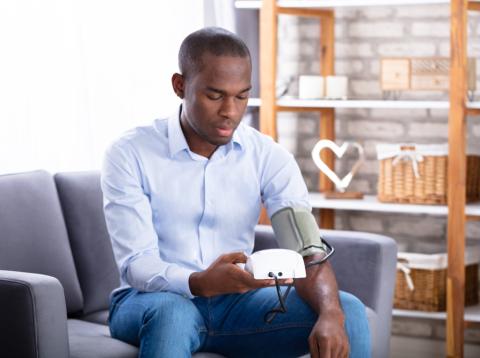NIH-Funded Study Looks at Blood Pressure Trends During Pandemic

Photo: Andrey_Popov/Shutterstock
Adults with hypertension saw a small but consequential rise in their blood pressure levels during the first eight months of the Covid-19 pandemic, while the number of times they had their blood pressure measured dropped significantly. Findings from this NIH-supported study appeared in Hypertension.
Hypertension, or high blood pressure, affects more than 1 billion people worldwide. Poor blood pressure control is a risk factor for cardiovascular disease, including heart attack and stroke, as well as a risk factor for more severe Covid-19 disease. Yet only about 1 in 4 U.S. adults with hypertension have their condition under control, according to CDC data. Widespread stay-at-home orders and lockdowns during the pandemic prompted some researchers to explore its impact on these patients.
In the current NHLBI-funded study, researchers looked at the electronic data records of 137,593 adults with hypertension and compared blood pressure outcomes before the pandemic (August 2018 through January 2020) with those during the peak of the pandemic (April 2020 through January 2021). The data came from three large U.S. health care systems: Cedars-Sinai in Los Angeles, Columbia University Irving Medical Center in New York and Ochsner Health in New Orleans. The average age of the patients was 66 years; 57% were female and 30% were Black.
The researchers discovered first that the number of blood pressure measurements patients had taken declined by as much as 90% in the first three months of the pandemic. While these measurements gradually increased in successive months, the total number of readings at the end of the study period remained below pre-pandemic levels. The researchers attributed this partly to cancellations or postponements of in-person office visits.
The researchers also found the patients’ blood pressure rose slightly on average, though studies show such slight increases in blood pressure can raise the risk of major cardiovascular events. Researchers plan to explore the impact of these slight blood pressure increases on long-term cardiovascular health outcomes as well as determine whether some groups may have had difficulty accessing telehealth resources.
“We expected blood pressure control to be worse due to decreased physical activity, stress, poor sleep and other cardiovascular disease risk factors that worsened during the pandemic,” said study leader Dr. Hiroshi Gotanda of Cedars-Sinai Medical Center. “But the results were better than we expected, probably because the use of telemedicine and home monitoring of blood pressure.”
The successful use of these alternatives to in-person office visits provides a model for improving blood pressure control in future disasters and public health emergencies.
